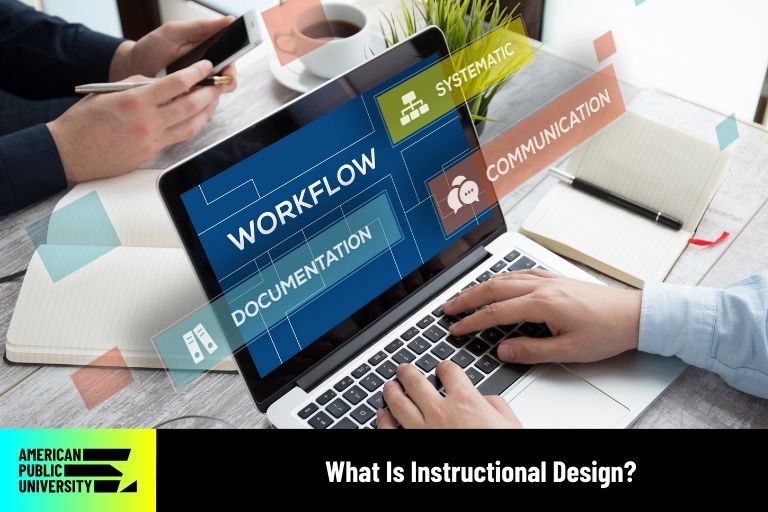05/20/2025

Understanding Instructional Design and Its Purpose
Instructional design is the behind-the-scenes blueprint that shapes how people learn. Whether it’s an employee onboarding session or an online course for adult learners, instructional designers may create experiences that are clear, engaging, and effective.
This field uses a systematic process to analyze learning needs, define goals, and create learning materials that aim to support specific learning outcomes. The approach blends insights from learning theories, cognitive psychology, and educational psychology to support how people absorb and retain information.
While instructional design is used across industries, it’s especially common in higher education, government organizations, and corporate training. The goal is usually to create effective, learner-centered materials that build knowledge and real-world skills.
Instructional Design in Action
Instructional designers are professionals who plan, develop, and evaluate educational content. They may use eLearning tools, design training programs, or support online courses that help learners reach specific objectives.
Because no two learning environments are the same, instructional designers work in a range of settings, from designing job aids and video tutorials to mapping out instructional objectives for full curriculum design projects.
A few common examples of where instructional designers create learning experiences include:
- A government organization developing a training module for public service roles
- A university designing digital learning materials for a remote degree program
- A company rolling out a new compliance training through its learning management system
In each case, instructional designers use a systematic approach to create content that supports desired learning outcomes, while staying aligned with organizational goals.
Instructional Design Theory and Frameworks
The work of instructional designers is grounded in theory, specifically, instructional design theory that guides how lessons are structured and delivered. These theories help professionals understand how to motivate learners, structure content, and support long-term retention.
For instance, Bloom’s Taxonomy categorizes learning into six levels, from remembering to creating, which helps align goals with the type of thinking required. This framework is commonly used to design courses that promote critical thinking and deeper understanding.
Other learning theories influence how designers structure content and experiences. These include:
- Behaviorist theories, which focus on reinforcement and measurable performance
- Cognitive psychology, which emphasizes memory, organization, and processing
- Constructivist approaches, which encourage learners to build their own understanding through active engagement
These instructional design methods provide structure, though designers often tailor them depending on the target audience, content, and learning goals.
The Value of Instructional Design Models
When it’s time to map out a course or training, instructional design models provide a practical framework. These models help designers think through each stage, from planning to delivery.
One of the most well-known is the ADDIE model, which stands for Analyze, Design, Develop, Implement, and Evaluate. It’s a step-by-step process that helps guide the full lifecycle of a course or program.
Other common models include:
- SAM (Successive Approximation Model) – emphasizes rapid prototyping and iteration
- Gagné’s Nine Events of Instruction – provides a sequence for teaching new concepts
- Merrill’s Principles of Instruction – focuses on real-world problem-solving
- Kirkpatrick’s Evaluation Model – evaluates training success based on outcomes like engagement, learning, and behavior
These instructional design methods provide structure, but designers often adapt them depending on the target audience, content, and learning goals.
Understanding the Instructional Design Process
The instructional design process generally follows a cycle—one that includes research, planning, creation, delivery, and feedback. It’s flexible enough to support both traditional classrooms and online learning environments.
Here’s how the process often unfolds:
- Analysis: Identify gaps, define learning objectives, and understand the learning needs of the audience
- Design: Plan the flow of content, choose instructional strategies, and select tools or formats (like interactive media or simulations)
- Development: Build the actual instructional materials, such as videos, assessments, or digital lessons
- Implementation: Deliver the materials through platforms like online courses, in-person training, or hybrid formats
- Evaluation: Use feedback and data to determine if the content achieved its intended learning outcomes
Throughout this cycle, project management plays an important role. Instructional designers coordinate with subject matter experts, manage timelines, and ensure that quality standards are met.
Understanding Adult Learning Theories
Many instructional designers develop content for adult learners. That’s where adult learning theories come in, offering guidance on how to create relevant, motivating materials for this audience.
For example, Knowles’ Theory of Andragogy emphasizes self-direction and the value of experience in adult learning. Other approaches draw from Maslow’s Hierarchy of Needs or Meier’s Accelerated Learning, focusing on factors like motivation, safety, and emotional connection.
These theories influence how instructional designers build learning solutions that aim to support adults who may be balancing work, family, and professional development.
Curriculum Design in Higher Education and Beyond
Instructional technology has transformed how people access and engage with education. In higher education, instructional designers help develop online courses, design digital textbooks, and adapt materials for diverse learners.
In government organizations, instructional designers may create training materials that teach specific procedures or policies. These programs often need to be scalable, accessible, and easy to update.
"Instructional design plays a role in developing materials for public policy education and outreach, where the goal is to share information in a way that’s accessible and actionable.
Shaping Curriculum Through Instructional Design Principles
Good curriculum design doesn’t just transfer knowledge; it helps learners apply it. That’s why instructional designers focus on aligning content with real-world goals. Whether it’s an introductory elearning course or a multi-week training series, instruction is often tied back to the skills or behaviors it’s meant to support.
By using structured frameworks and instructional design practices, designers may make content more engaging, relevant, and easier to remember.
The Future of Instructional Design
As new technologies continue to emerge, instructional designers are rethinking how people learn. Tools like virtual reality, artificial intelligence, and adaptive learning software are shaping the next generation of learning technology.
The future of this field may involve designing more personalized, accessible, and immersive learning experiences. At its core, instructional design aims to support learning in ways that are intended to be effective, meaningful, and memorable.
Becoming an Instructional Designer
If you’re curious about how to become an instructional designer, it may help to start with the basics: understanding how people learn, how content is designed, and how to assess what’s working. Many instructional designers begin by building a portfolio, earning an undergraduate certificate in instructional design, or exploring entry-level roles in education or training.
Strong soft skills like collaboration and communication matter just as much as familiarity with tools like authoring software or management systems. Whether working independently or within a team, professionals with instructional design skills may find roles in various fields depending on their experience and qualifications.
Professionals with instructional design skills may find roles in various fields depending on their experience and qualifications—depending on experience and skills—from education and public service to healthcare and corporate development.

